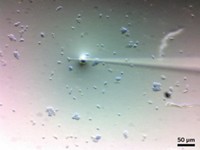Advertisement
Grab your lab coat. Let's get started
Welcome!
Welcome!
Create an account below to get 6 C&EN articles per month, receive newsletters and more - all free.
It seems this is your first time logging in online. Please enter the following information to continue.
As an ACS member you automatically get access to this site. All we need is few more details to create your reading experience.
Not you? Sign in with a different account.
Not you? Sign in with a different account.
ERROR 1
ERROR 1
ERROR 2
ERROR 2
ERROR 2
ERROR 2
ERROR 2
Password and Confirm password must match.
If you have an ACS member number, please enter it here so we can link this account to your membership. (optional)
ERROR 2
ACS values your privacy. By submitting your information, you are gaining access to C&EN and subscribing to our weekly newsletter. We use the information you provide to make your reading experience better, and we will never sell your data to third party members.
Analytical Chemistry
Spying On Single Cells
Microfluidics: A test detects the activity of single enzymes associated with drug resistance in cancer cells
by Katherine Bourzac
October 10, 2011

A test that detects the activity of a specific enzyme in individual human cells could predict how cancer patients will respond to chemotherapy drugs. The method, which uses microfluidics to single out cells for rapid testing, illuminates subtle cell-to-cell variations that could determine the course of disease but that existing tests miss (ACS Nano, DOI: 10.1021/nn203012q).“Chemotherapy produces variable results,” says Kam W. Leong, professor of biomedical engineering at Duke University. For example, some patients’ tumors don’t respond at all to a family of cancer drugs called camptothecins, while others’ tumors develop resistance to the drugs over time. Researchers believe that subtle biochemical differences between tumor cells produce such variable outcomes. But current analytical methods are incapable of detecting these differences. These techniques provide details only about the average behavior of a large group of cells, says Norman Dovichi, professor of chemistry at the University of Notre Dame.Leong and Birgitta R. Knudsen, professor of molecular biology and genetics at Aarhus University, in Denmark, wanted to develop a system that tests cells individually for the activity of a specific enzyme. They picked the enzyme hTopI, which many cancer cells produce a lot of and which camptothecins target. The enzyme’s function is to nick DNA strands.
In Leong and Knudsen’s microfluidic device, three water-based streams—one containing human cells, another synthetic DNA probes, and the third cell-bursting enzymes—meet at an outlet channel. Just as the streams combine, a perpendicular stream of oil chops the water stream into oil-coated droplets that act as 100-pL reaction chambers. Inside a droplet, the cell bursts open and spills its contents, including its load of enzymes, which may include hTopI. Spilled hTopI nicks the DNA probes, initiating a reaction that converts the molecules into circular DNA.
Meanwhile, the device’s fluidics shuttle each droplet to one of a series of traps on a glass microscope slide. Each trap has a coating of DNA molecules that can initiate the amplification of a single circular DNA molecule. By adding fluorescent probes, the researchers can detect the amplified DNA indicating the presence of even one hTopI molecule inside a single cell.
To prove that the device works, the team ran human embryonic kidney cells through the device. Most of the oil droplets contained one cell, but some had no cells, and others had a cluster of them.
The researchers then showed that the system could detect extremely rare activities of another enzyme in a mixture of cells. They detected a very small number of cells expressing Flp recombinase, a cancer-related enzyme, mixed among millions of cells that didn’t express it.
Dovichi calls Knudsen and Leong’s test “a real tour de force,” and one of the most sensitive yet developed. But just what biologists and clinicians will be able to do with this level of detail isn’t yet clear, he says, because tests with this kind of sensitivity are just emerging.
Knudsen’s group now plans to test colon cancer cells from patient biopsies in hopes of learning more about camptothecin resistance. Meanwhile, Leong’s group is working to improve droplet creation, so that each drop contains a single cell.




Join the conversation
Contact the reporter
Submit a Letter to the Editor for publication
Engage with us on Twitter